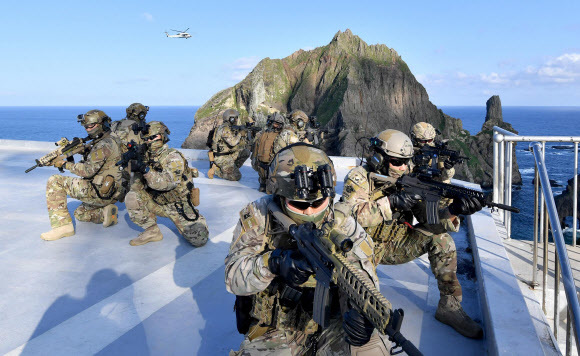 |
|
The South Korean Navy conducts a “territorial defense exercise for the East Sea” on Doko on Aug. 25. (provided by the Republic of Korea Navy)
|
Exercise seems designed to irritate Japan after GSOMIA withdrawal
On Aug. 25, the South Korean military abruptly initiated a “territorial defense exercise for the East Sea,” an expanded version of the “Dokdo defense exercise” that had been postponed since June. This move came just three days after South Korea terminated its information-sharing agreement with Japan, known as the General Security of Military Information Agreement (GSOMIA). While this is a routine exercise designed to reinforce the country’s resolve to defend its territory, including the island of Dokdo, it has always received pushback from Japan. As such, the exercise seems designed to irk Japan, on the heels of the GSOMIA withdrawal. Participating for the first time in the exercise was the 7,600-ton ROKS Sejong the Great, an Aegis guided-missile destroyer in the South Korean Navy’s Maritime Task Flotilla Seven, regarded as one of the finest vessels in the fleet. Commissioned in December 2008, the Sejong the Great was South Korea’s first Aegis-equipped destroyer with a SPY-1D radar-based combat system. It is capable of detecting aerial targets beyond a range of 1,000km and attacking up to 20 or so targets simultaneously. “There was military strength taking part from the Maritime Task Flotilla Seven, but the exercises are supervised by the 1st Fleet, which is responsible for the East Sea,” a navy official explained. Established in 2010, the Maritime Task Flotilla Seven possesses the Sejong the Great and two other Aegis-equipped destroyers along with the 4,500-ton Chungmugong Yi Sun-sin-class destroyer. The South Korean Army’s Special Forces were also taking part in the exercises for the first time. “Several dozen Army Special Forces troops took part in the exercises and joined the Marines in the Dokdo landing,” a Ministry of National Defense (MND) official explained. The landing of Army Special Forces on Dokdo was also a first. In addition to the Sejong the Great, around 10 Navy and Coast Guard vessels reportedly took part, along with around 10 Army, Navy, and Air Force aircraft including the F-15K, the Air Force’s main fighter. “The inclusion of the Sejong the Great and Army Special Forces for the first time in the exercises was meant to signal our commitment to bringing all of our capacities to bear to protect our territory,” a Navy official said. “The fighting power this time was around twice as large as in past years,” the official added. The Dokdo defense exercises, which have been carried out in the first and second halves of the year since 1986, have typically included 3,200-ton Kwanggaeto the Great class Destroyer (DDH) and P-3C maritime patrol aircraft from the Navy, along with Coast Guard vessels and Air Force F-15K fighter aircraft.
 |
|
ROKS Sejong the Great, an Aegis guided-missile destroyer in the South Korean Navy’s Maritime Task Flotilla Seven, joints other vessels in a territorial defense exercise for the East Sea on Aug. 25. (provided by the ROK Navy)
|







